EAC Vs CDex SecureMode: Difference between revisions
m (→External links) |
No edit summary |
||
| (3 intermediate revisions by 2 users not shown) | |||
| Line 45: | Line 45: | ||
Read error, takes forever. | Read error, takes forever. | ||
==Bad CDR== | ==Bad CDR== | ||
| Line 125: | Line 122: | ||
==External links== | ==External links== | ||
* [http://www.hydrogenaudio.org/index.php?act=ST&f=20&t=3164 Original post by Pio2001] | * [http://www.hydrogenaudio.org/index.php?act=ST&f=20&t=3164 Original post by Pio2001] | ||
[[Category:Comparison of CD ripping techniques]] | |||
Latest revision as of 22:30, 29 July 2010
This test is aimed at knowing if these programs can guarantee a perfect audio extraction from an audio CD when it is possible, in other words, do they really warn the user as soon as any error occurs?
The test was run with Windows 98, Aspi layer 4.71, and a Memorex DVD-Maxx 1648 IDE drive, that supports C2 and have no cache according to both EAC and Feurio.
A CDR that was becoming barely readable was used. As the results seemed strange, a quick test was made with a scratched CD, and another CD with a hole in it, in order to ensure that CDex is working properly. Here are the results of these tests first, then the real test about secureness.
CDex was set in full paranoia, Feurio has C2 error detection enabled, EAC was in secure mode, accurate, no cache, C2.
CD with a hole in it
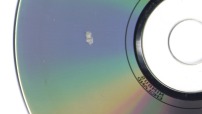
CDex
The drive makes strange noises at 82 % of track 2, the extraction slows down completely, no jitter error is detected, I cancel, afraid to damage the drive.
Feurio
C2 error reported at 71% of track 2. I check ignore all. The drive makes noises at 87 %, the extraction completely slows down at 89%, I cancel.
EAC
Error detected at 71%, uncorrectable error at 73%, then endless error correction takes place. I cancel.
Scratched CD
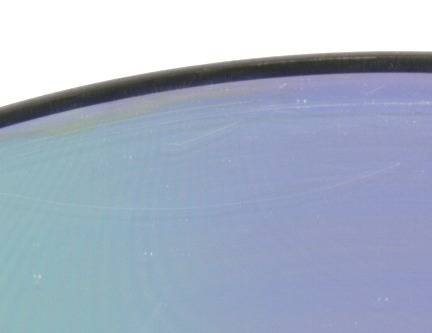
CDex
This time, jitter errors (2) are reported. Extraction takes forever.
Feurio
A C2 error is reported, then the extraction takes forever
EAC
Read error, takes forever.
Bad CDR
One of the tracks is bad enough to produce clicks, but not enough to stop the extraction.
EAC
"There were errors".
Reports 16 isolated suspicious positions, and 2 whole ranges of suspicious positions. Track quality 94.5 %
No C2: "there were errors", reports 16 isolated suspicious positions, and 5 whole ranges of suspicious positions. Track quality 96.7%
No C2 + cache: I canceled the extraction after 2 hours of error correction.
Feurio
Reports 9,462 C2 errors!
CDex
Zero errors!
In order to check if there were really no errors in the CDex wav, and in order to get an idea of the sound quality, the track was extracted again with EAC and CDex, so that we have now 6 wav files : 2 from CDex, zero errors, 2 from EAC with C2, some errors, and 2 from EAC without C2, some errors.
If there are really zero errors in the CDex files, there should be no differences at all between them. Let's check with EAC's compare wav:
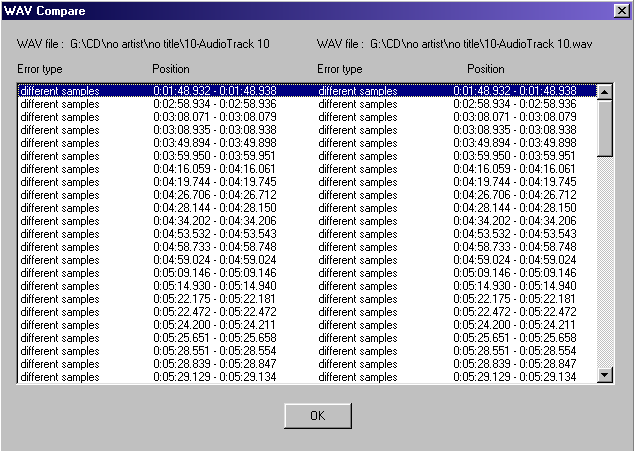
Notice the scrollbar at the right side of the window. There is obviously a problem with CDex here, all these errors went unnoticed through the full paranoia mode. It is active though, since two errors were reported with the scratched CD.
Using SoundForge, let us invert one of each pair of wavs, and mix-paste it over the other one, so that only differences remain. All remaining noise will be read errors, but the absence of noise won't mean no error, since the same error can have occured the same way in both wavs. Since the result can vary from nothing to twice the error (if the sample was misread with opposite errors), the result gives an idea of the average read errors.
CDex
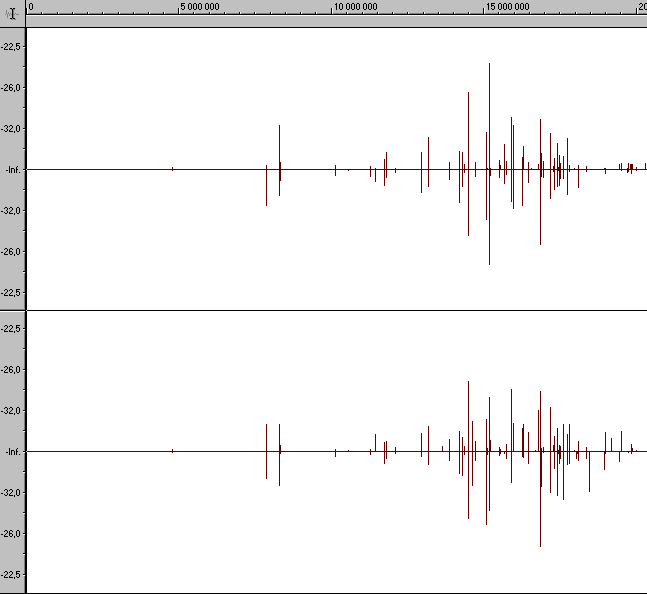
This shows the entire track. The highest peak is -23.72 db. Some little clicks can be heard in quiet parts.
EAC with C2
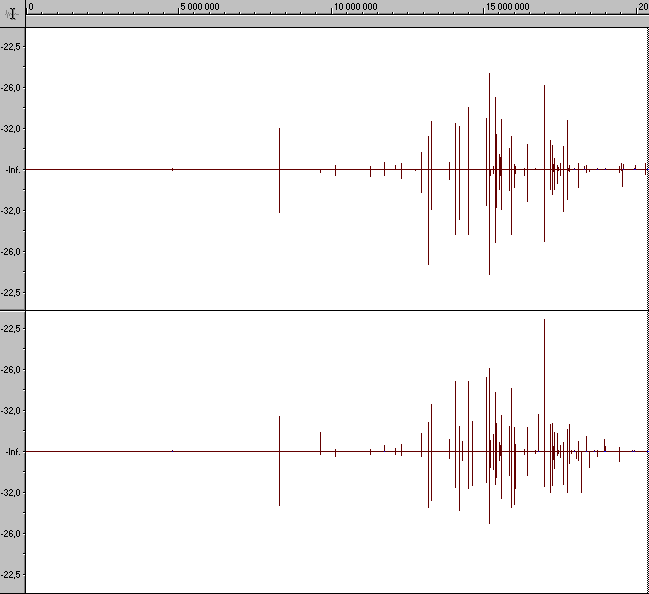
The scaling is the same as in the previous picture. The highest peak is -21.85 db. It looks and sounds quite the same as CDex file.
EAC without C2
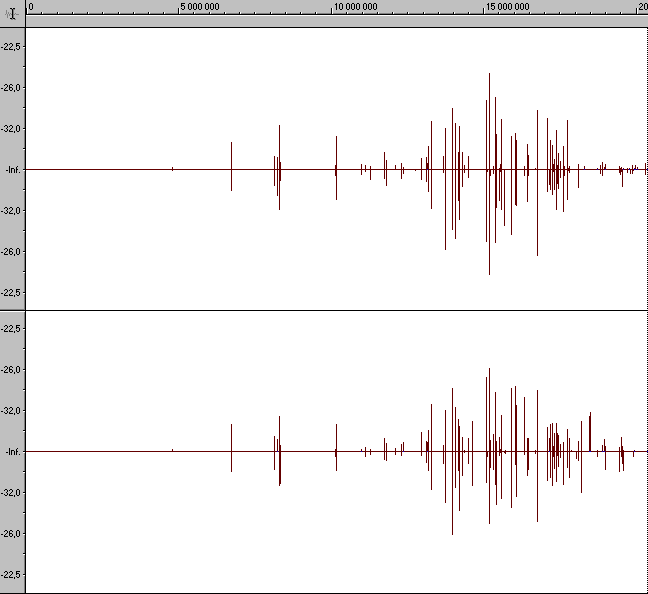
There seems to be a little more clicks, but the difference is small.
Also, the CDex file seems to have less clicks than EAC with C2 in the main part, but more isolated ones on the left. Therefore nothing can be concluded about the reading quality of the programs themselves, because the exact number of clicks varies from a reading to another. Here, we can say that the three results are quite the same, if we take into account the variations that can occur.
To be able to judge the reading quality, many more extractions would need to be made, in order to make statistics and to evaluate how stable the quality is for a given ripping mode, then to deduce if the differences between the files are due to the programs, or to random variations.
Conclusion
With the Memorex DVD-Maxx 1648 drive, CDex is of no use compared to EAC, it returns files full of errors and audible clicks claiming zero errors occured even in full paranoia mode.
Though the C2 error detection is currently very criticized, it is still, at least for this drive, infinitely more accurate (9462 times more accurate, according to Feurio ) than CDex full paranoia mode, and as accurate as the reading twice method in EAC, while much faster.
This conclusion stands for the Memorex DVD drive. As we don't know how the paranoia mode works, other drives should be tested the same way in order to confirm this result.
